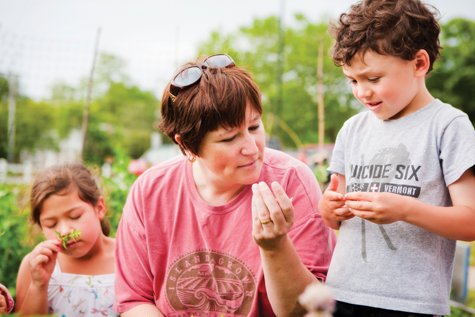COMMUNITY

Island Grown Schools
The Island Grown Initiative's Farm-to-School Program
Story by Kara Goldfarb, Photography by Randi Baird
People may come for the beaches and sunsets, but if you stick around long enough you’ll take notice of the thriving agriculture. Noli Taylor definitely did. After working with several environmental non-profits across the country, and then moving to Hawaii to work on a campaign around agriculture issues and genetic engineering, Noli moved to the Vineyard, where she saw an amazing opportunity. “There is such an incredible agricultural history here and it’s still locally controlled and there are still so many family farms and it feels like you can do so much in the world of agriculture,” Noli says. She started working for Island Grown Initiative, the Island’s non-profit organization for sustainable agriculture. From Island Grown Initiative, Noli became the Program Coordinator of Island Grown Schools, the Vineyard’s farm-to-school program that launched in 2007. Noli understood from the start that so many of the problems with our food system such as childhood obesity, a lack of connection to nature, and family eating habits, could all be brought back to the youngest generation of children, “but it wasn’t until we actually got our start with community meetings that I realized how important and central it is to work with kids, and what better place to do that than at school.” she says.
Since that initial community meeting Island Grown Schools has really taken off in, how Noli describes it as, “a really grassroots kind of way.” Discussions during the monthly community meetings focused on brainstorming which types of farm-to-school programs worked best for the Island. “Each of our k-12 schools are so different from each other and they operate pretty independently,” says Noli. The conclusion was then to break up into working groups by school. “By being able to be specific about what was the best fit for each school community we were able to make the program grow in a way that felt right to each school.” The West Tisbury School, for instance, started by building a garden. Other schools thought about cafeteria waste, while others centered in on curriculum, or farm field trips. In this way, an astounding amount of progress was made in just the first couple years. Another factor in the rapid growth of IGS: a strong level of enthusiasm amongst the staff. “By having these community meetings where everyone was coming together and sharing what they were doing people were inspired by each others work,” Noli explains, “and that I think helps build on the momentum.”
While feats like IGS’s garden installations at seven schools in the first few years were a rousing success, not everything came with such ease. Like any major endeavor, there were barriers that had to be crossed. One such barrier came from the ambiguity surrounding food service programs. An early goal of IGS was to get local food into school meals. “One of the first things we found was the schools and cafeteria directors weren’t sure what they were allowed to use,” Noli says. “There was an idea that food had to come from a certain approved source, but nobody really knew what that meant,” she continues. Ultimately, after calling the State Department of Education (who have a health and nutrition branch), it was established that the only people doing the approving were the cafeteria directors themselves and they were free to purchase from whomever they wanted. Once everyone was clear on the regulations, getting more local food in the cafeterias became a reality. “There have been all these things were people thought you couldn’t do certain things and then it turned out it was okay and that has been a good process for us to go through,” Noli says.
An instance that proved to be even more complicated was the process of moving the two up-Island schools away from their corporate food service contract. “A lot of school districts all across the country contact out their meal programs to private corporations,” Noli explains. “And this has been problematic for the up-Island schools for a number of reasons from food quality to labor issues for the cafeteria workers,” she says. The objective was to bring control of the Chilmark and West Tisbury meal programs back to the schools themselves. The main obstacle came not from the corporation, Chartwells, but from the school kitchen. “The West Tisbury School didn’t have the capabilities to prepare meals from scratch. So to even think about moving away from the corporate contract we had to think about what it would take to change the infrastructure of the kitchen,” Noli says. The school thought it would cost $750,000 to make the kitchen workable, but in the end builders and electricians and plumbers who had children in the West Tisbury and Chilmark schools stepped up and volunteered to do the work in bringing the kitchen up to code, bringing down the budget to $100,000. After several community members donated equipment, and others showed their support at school meetings, the meals program became a reality this school year. “It’s an incredible thing to see after years and years of dreaming that this could be possible to know we’ve really done it,” Noli says.
The challenges that IGS faces may be tough, but overcoming them becomes all the more rewarding. When people from all corners of the Island are able to contribute something, it demonstrates the philosophy that we’re all in this together. “It’s a special thing about the Vineyard,” Noli adds, “that so many different parts of the community have come together to make it happen.” It’s precisely that ability to work together that makes for a road map which others can follow. “Were being approached by people from other communities for support in starting their own farm-to-school efforts,” states Noli. From Virginia to Puerto Rico, Island Grown Schools has helped with establishing school gardens, food policies, and integrating agricultural curriculum. This year, a more official community mentorship program is starting. Beginning with the Cape and Islands in January and February, the program will help spread the motto of IGS and will also be a step in regionalizing our food system.
For now, Island Grown Schools continues to thrive on its own by constantly coming up with new things and always including as much of the community as it can. The latest is Island Grown Harvest of the Month. Last winter, Noli and another staff member had the chance to visit farm-to-school programs in California and Oregon. The Harvest of the Month in Portland public schools really caught Noli’s attention. “We’ve been trying to think of ways to engage not just the students, but parents and caregivers. When I saw Harvest of the Month in Portland I thought this would be a great approach,” she says. The concept is to take a different locally available ingredient each month and highlight it first in the school cafeterias as well as classroom lessons, and then in the grocery store and in restaurants. This way, when students are shopping with their parents the same poster from school is hanging in the produce aisle, and they can say: “oh hey we’re having this at school, let’s try it!” Additionally, there are featured recipes contributed by local chefs for families to try and restaurants serving the item of the month. “We’re the first district in Massachusetts to try it out and this is our first month, but so far it’s going great!” Noli exclaims. “It helps get a whole community involved in thinking about what’s in season.” There’s even a local artist who does a painting each month for the posters.
As the winter encroaches upon us, the cold months aren’t typically thought of as a growing time, but there’s no sign of slowing down. By finding crops that can grow during the school year, investing in greenhouses and cold frames, doing lessons inside on nutrition and farming, and year round farm trips, the farm-to-school programs are maintained even throughout the winter. “Because the schools operate all through the winter,” Noli explains, “it’s a great market and a great opportunity to figure out what kind of elements need to get created so we can have a real year round local food system.”
Serving local all year provides an opportunity for farmers to make a larger profit during the wintertime. With seven farms selling directly to the schools and serving over a thousand meals a day, it’s a big enough market to justify investing in things like more greenhouses, so that farmers can extend their season and bring even more local food to everyone for more of the year. It’s a cycle that, with the dedicated members of Island Grown Schools, has unlimited potential. “Now we’re really seeing that change,” Noli says.
So soak up the last of the beach days and the final summer sunsets, but as the fall and winter roll forward, take witness to all that is being done in terms of agriculture. In terms of a society coming together. It may just be a reason to stay.
Since that initial community meeting Island Grown Schools has really taken off in, how Noli describes it as, “a really grassroots kind of way.” Discussions during the monthly community meetings focused on brainstorming which types of farm-to-school programs worked best for the Island. “Each of our k-12 schools are so different from each other and they operate pretty independently,” says Noli. The conclusion was then to break up into working groups by school. “By being able to be specific about what was the best fit for each school community we were able to make the program grow in a way that felt right to each school.” The West Tisbury School, for instance, started by building a garden. Other schools thought about cafeteria waste, while others centered in on curriculum, or farm field trips. In this way, an astounding amount of progress was made in just the first couple years. Another factor in the rapid growth of IGS: a strong level of enthusiasm amongst the staff. “By having these community meetings where everyone was coming together and sharing what they were doing people were inspired by each others work,” Noli explains, “and that I think helps build on the momentum.”
While feats like IGS’s garden installations at seven schools in the first few years were a rousing success, not everything came with such ease. Like any major endeavor, there were barriers that had to be crossed. One such barrier came from the ambiguity surrounding food service programs. An early goal of IGS was to get local food into school meals. “One of the first things we found was the schools and cafeteria directors weren’t sure what they were allowed to use,” Noli says. “There was an idea that food had to come from a certain approved source, but nobody really knew what that meant,” she continues. Ultimately, after calling the State Department of Education (who have a health and nutrition branch), it was established that the only people doing the approving were the cafeteria directors themselves and they were free to purchase from whomever they wanted. Once everyone was clear on the regulations, getting more local food in the cafeterias became a reality. “There have been all these things were people thought you couldn’t do certain things and then it turned out it was okay and that has been a good process for us to go through,” Noli says.
An instance that proved to be even more complicated was the process of moving the two up-Island schools away from their corporate food service contract. “A lot of school districts all across the country contact out their meal programs to private corporations,” Noli explains. “And this has been problematic for the up-Island schools for a number of reasons from food quality to labor issues for the cafeteria workers,” she says. The objective was to bring control of the Chilmark and West Tisbury meal programs back to the schools themselves. The main obstacle came not from the corporation, Chartwells, but from the school kitchen. “The West Tisbury School didn’t have the capabilities to prepare meals from scratch. So to even think about moving away from the corporate contract we had to think about what it would take to change the infrastructure of the kitchen,” Noli says. The school thought it would cost $750,000 to make the kitchen workable, but in the end builders and electricians and plumbers who had children in the West Tisbury and Chilmark schools stepped up and volunteered to do the work in bringing the kitchen up to code, bringing down the budget to $100,000. After several community members donated equipment, and others showed their support at school meetings, the meals program became a reality this school year. “It’s an incredible thing to see after years and years of dreaming that this could be possible to know we’ve really done it,” Noli says.
The challenges that IGS faces may be tough, but overcoming them becomes all the more rewarding. When people from all corners of the Island are able to contribute something, it demonstrates the philosophy that we’re all in this together. “It’s a special thing about the Vineyard,” Noli adds, “that so many different parts of the community have come together to make it happen.” It’s precisely that ability to work together that makes for a road map which others can follow. “Were being approached by people from other communities for support in starting their own farm-to-school efforts,” states Noli. From Virginia to Puerto Rico, Island Grown Schools has helped with establishing school gardens, food policies, and integrating agricultural curriculum. This year, a more official community mentorship program is starting. Beginning with the Cape and Islands in January and February, the program will help spread the motto of IGS and will also be a step in regionalizing our food system.
For now, Island Grown Schools continues to thrive on its own by constantly coming up with new things and always including as much of the community as it can. The latest is Island Grown Harvest of the Month. Last winter, Noli and another staff member had the chance to visit farm-to-school programs in California and Oregon. The Harvest of the Month in Portland public schools really caught Noli’s attention. “We’ve been trying to think of ways to engage not just the students, but parents and caregivers. When I saw Harvest of the Month in Portland I thought this would be a great approach,” she says. The concept is to take a different locally available ingredient each month and highlight it first in the school cafeterias as well as classroom lessons, and then in the grocery store and in restaurants. This way, when students are shopping with their parents the same poster from school is hanging in the produce aisle, and they can say: “oh hey we’re having this at school, let’s try it!” Additionally, there are featured recipes contributed by local chefs for families to try and restaurants serving the item of the month. “We’re the first district in Massachusetts to try it out and this is our first month, but so far it’s going great!” Noli exclaims. “It helps get a whole community involved in thinking about what’s in season.” There’s even a local artist who does a painting each month for the posters.
As the winter encroaches upon us, the cold months aren’t typically thought of as a growing time, but there’s no sign of slowing down. By finding crops that can grow during the school year, investing in greenhouses and cold frames, doing lessons inside on nutrition and farming, and year round farm trips, the farm-to-school programs are maintained even throughout the winter. “Because the schools operate all through the winter,” Noli explains, “it’s a great market and a great opportunity to figure out what kind of elements need to get created so we can have a real year round local food system.”
Serving local all year provides an opportunity for farmers to make a larger profit during the wintertime. With seven farms selling directly to the schools and serving over a thousand meals a day, it’s a big enough market to justify investing in things like more greenhouses, so that farmers can extend their season and bring even more local food to everyone for more of the year. It’s a cycle that, with the dedicated members of Island Grown Schools, has unlimited potential. “Now we’re really seeing that change,” Noli says.
So soak up the last of the beach days and the final summer sunsets, but as the fall and winter roll forward, take witness to all that is being done in terms of agriculture. In terms of a society coming together. It may just be a reason to stay.








